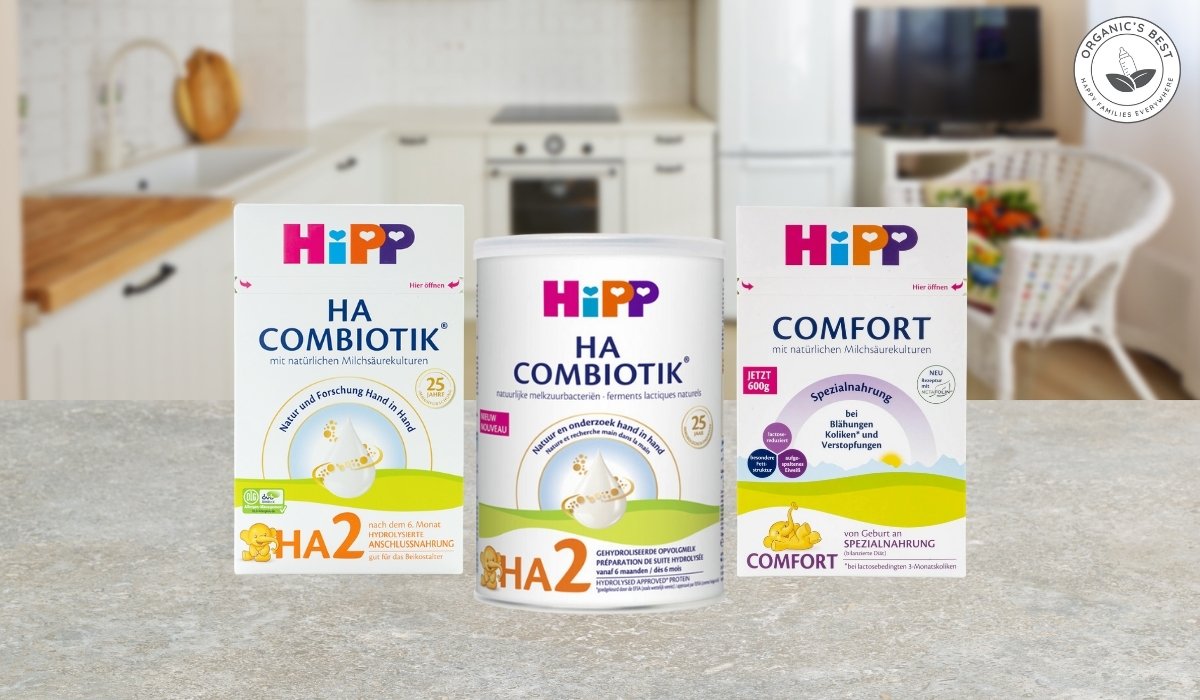Click to Get 2 FREE Boxes/Cans
Only New Customers! Click HERE to Get 2 Extra Boxes/Cans for Free With Your First Order.
BABY FORMULA
Offering new parents top-quality European infant formula from renowned brands like HiPP, Holle, Kendamil, and more. If you’re uncertain about which product to choose, our Formula Finder can help you make the best decision for your baby.
Baby Food
Offering new parents a premium selection of European baby foods, including jars, pouches, cereals, and snacks from esteemed brands like HiPP and Holle.
Best Hypoallergenic Formula: Top 4 European Picks
by Agustina Fernandez February 05, 2024 15 min read

As parents, you place a great deal of care into selecting the best nutrition for your baby. But this can be tricky if you have to take into account allergies or intolerances. Thankfully, there is a whole variety of specialty formulas designed just for these extra-sensitive little ones!
Hypoallergenic infant formula, or HA formula for short, is crafted with gentle ingredients designed to help comfortably nourish growth and reduce the risk of allergic reactions for babies with specific dietary needs. Thanks to the help of tiny broken-down proteins, your baby's delicate digestive system is given some much-needed relief to better tolerate their milk.
In this article, we'll be focusing on the top 4 best hypoallergenic formula options from Europe. We also discuss important differences between allergies and intolerances and examine the many types of hypoallergenic baby formulas available.
Keep reading for an in-depth guide to European hypoallergenic formulas, including when to use them, their pros and cons, and, finally, what American hypoallergenic baby formula they compare to!
Table of contents
- Things To Consider When Choosing Hypoallergenic Formulas
- Ranking The Best Hypoallergenic Baby Formula
- #1 HiPP HA Formula (Dutch Version) - Best tasting hypoallergenic formula
- #2 HiPP HA Formula (German Version) - Best tasting hypoallergenic formula
- HiPP HA as an Alimentum® Alternative
- #3 HiPP Comfort - Best extensively hydrolyzed baby formula
- #4 Bebe M - Best organic hypoallergenic formula
- Lactose Intolerance vs Cow's Milk Protein Allergy
- What are the different types of hypoallergenic baby formula?
- What hypoallergenic formula is best?
- Scientific References
Things To Consider When Choosing Hypoallergenic Formulas
Before we jump into the best hypoallergenic baby formulas, let's start by discussing a few important considerations to keep in mind while searching among hypoallergenic formula brands!

Allergy or Sensitivity
If you suspect your child may have a cow milk allergy or intolerance, consult your pediatrician for proper diagnoses and treatment. They can distinguish between cow milk protein allergies (CMPA), lactose intolerance, and simple digestive discomfort.
We will also cover the differences in depth at the end of this article. After assessment, your baby's doctor will determine whether your little one requires a hypoallergenic formula or if they can stay on a regular formula.
Your Baby's Age
Roughly 50% of babies with CMPA outgrow this allergy by the time they reach 12 months. For this reason, we encourage parents to monitor their little ones closely to see if their health conditions and nutritional needs are changing.
It might be that your baby can later be transitioned to a different type of formula as they outgrow the need for a hypoallergenic formula. However, it's always best to discuss any dietary or health changes with your pediatrician.
With these points in mind, let's move on to our deep dive into the best hypoallergenic infant formula and explore non-GMO and organic formula options!
Ranking The Best Hypoallergenic Baby Formula
We're here to help you on your formula-finding journey! To do so, we have spent hours researching formulas, scrutinizing scientific studies, and analyzing ingredient lists so that we can give trustworthy and reliable recommendations based on the latest findings in infant nutrition. We encourage you to check out our "How We Review Page" for more details about our standards for rating each product.

To make our ranking system as comprehensive as possible, we have evaluated the best hydrolyzed formula based on five key criteria: European organic certification, non-GMO ingredients, lactose or milk as the primary ingredient, no added sugars or artificial sweeteners, and the inclusion of ARA & DHA.
We've also awarded bonus points for the inclusion of probiotics and prebiotics and the absence of maltodextrin, starch, and palm oil. Each performance category is assigned 1 point for a maximum of 10 points in total.

#1 HiPP HA Formula (Dutch Version)
HiPP HA leverages 25 years of immunology research to deliver a powerful blend of ingredients designed to balance immunity and offer protection to babies with a family history of allergies.
HiPP HA boasts a combination of easy-to-digest hydrolyzed whey protein and the pairing of prebiotics and probiotics, which help strengthen your baby's intestinal barrier to protect against unwanted allergic reactions. Finally, HiPP HA has a mild taste that babies love, and parents have compared it to the flavour of human milk.
Please consult your pediatrician to see if this formula is a good match for your baby, as HiPP HA may not be suitable for little ones with CMPA.
Pros ✔️
- Digestible low-allergen hydrolyzed proteins
- Immune-supporting probiotics & prebiotics
- Based on 25 years of immunology research
Cons ❌
- Contains sustainably sourced palm oil
- Not certified organic
Leading Qualities of HiPP Dutch HA
In our research, we've seen that many hypoallergenic formulas do not hold European organic certification. This is because, under organic regulations, formulas that contain hydrolyzed milk protein, such as HiPP HA, cannot be certified as organic. However, this doesn't impact the quality of this formula, and HiPP HA is still free from genetically modified organisms (GMOs).
One of our favourite features of HiPP Dutch formula is its use of lactose as the only carbohydrate source. This ensures an easily digestible source of energy modeled after the main carbohydrate in breast milk.
HiPP formulas are also free from added sugars and artificial sweeteners like corn syrup solids. We've noted this as a benefit because current research states that if a child is exposed to added sugars in infancy, this can lead to early an increased intake of sugar later in childhood. To combat this, The American Academy of Pediatrics (AAP) recommends babies under 2 years old avoid added sugars.
We're also always happy to find the fatty acids ARA (Omega-6) and DHA (Omega-3) in this formula, which are added in an optimally balanced ratio to support eye and brain development.
Bonus Points Awarded to HiPP Dutch HA ☆
Astonishingly, more than 80% of our immune cells can be found in our intestines; this means that having healthy and balanced intestinal bacteria lays the foundation for a strong immune system. For this reason, HiPP HA uniquely contains a proven combination of probiotics originally extracted from real breast milk and prebiotics to help fortify your baby's intestinal wall and protect against allergens and unwanted bacteria!
We've awarded this formula two bonus points for excluding both starch and maltodextrin. While these complimentary carbs are safe, they can be more difficult to digest and thus are not useful in this gentle formula with a simple lactose base.
While we are sometimes iffy about palm oil in baby formula due to potential health and ecological concerns, HiPP sources their palm oil from fair and sustainable production. So, while we did remove a point, we are impressed with the mindful approach that HiPP has taken to harvesting this ingredient.
#2 HiPP HA Formula (German Version)
Instead of repeating the same information described above, we thought it was important to note that HiPP's Dutch and German hypoallergenic formula variations have the same recipe, so you do not have to worry about your baby missing out on any nutritional goodness.
The main difference between the two European formulas is the packaging. While HiPP German hypoallergenic formula comes in boxes of 600g or 200g ready-to-feed bottles, the Dutch variation comes in cans of 800g. We wanted to include this fact in case this can help you decide between the two.
Moreover, the German version offers two infant formula stages (PRE and 1) and one follow-on formula, stage 2. In contrast, the Dutch version only offers Stage 1 infant formula and Stage 2 follow-on formula.
HiPP HA as an Alimentum® Alternative
As you may be aware, Abbott Nutrition, the manufacturer of Similac®, voluntarily recalled various Alimentum® products in 2022 after reports of infants becoming ill came to their attention. For this reason, many parents have been seeking the best Alimentum® alternative. To help you make an informed decision, we will provide a comparison between the powdered version of Alimentum® Step 1 and HiPP HA.
Similac® Alimentum® and HiPP HA are both hypoallergenic infant formulas. The Alimentum® formula is marketed toward babies with CMPA, severe food allergies, or protein sensitivity-related colic. Whereas HiPP HA is intended for babies with a family history of allergies.
Based on our performance points, we awarded HiPP HA Dutch an almost perfect score of 8 out of 10 points. It lost 2 points due to the inclusion of palm oil and its lack of European organic certification. However, on the same rating system, Alimentum® scores a 1 out of 10. We will cover the rationale behind this next.

How Similac® Alimentum® Scores on our Main Performance Points:
Alimentum® is not organic or non-GMO, but notably, it does contain milk from cows not treated with artificial growth hormones.
The first ingredient in Alimentum® formula is corn maltodextrin. From our research, a study assessing tolerance to lactose in babies with cow's milk allergy found that ''Even children hypersensitive to cow's milk are clinically tolerant to lactose and can safely consume foods and drugs with lactose from bovine sources as an ingredient.'' For this reason, the exclusion of lactose from Similac's formula may be unwarranted.
Furthermore, Similac® Alimentum® adds sucrose, also known as table sugar, to their recipe. While this ingredient can help make the formula more appealing to babies, as hydrolyzed milk proteins can sometimes be bitter in taste, the AAP states that children under 2 years of age do not need added sugar in their diet.
What we did appreciate about Alimentum® is that it contains both ARA and DHA, and this is where Similac® achieved their single point in our review.
How Similac® Alimentum® Scores on our Bonus Performance Points:
Whereas a critical component of HiPP HA formula is the inclusion of pro and prebiotics, Similac® Alimentum® skips out on these immune-supporting ingredients.
Additionally, as discussed above, this formula does contain maltodextrin as a carbohydrate source, but it also contains modified cornstarch. Although we prefer when formulas stick to lactose-only recipes, without lactose, babies do need an alternative source of carbs, and these two ingredients achieve that.
Finally, like HiPP HA, Similac® Alimentum® also contains palm oil, although, unlike HiPP, it is not obtained from ecologically sustainable sources.
|
What Parents Say 💬 "Thankfully, I stumbled upon Organic's Best when we were down to just a 15-day supply of Nutramigen. As of this writing, there is still no Alimentum or Nutramigen (the only 2 hypoallergenic formulas sold in Canada) to be found in Canada. Organic's Best shipped very quickly, and their support staff answered any questions promptly. I am about to place my second order with Organic's Best and will be switching permanently to European formulas." |
#3 HiPP Comfort
HiPP Comfort is a special formula featuring a unique composition of extensively hydrolyzed whey proteins, reduced lactose levels, probiotics and prebiotics. It's crafted for little ones with conditions like excessive flatulence, lactose-related 3-month colic, and constipation. Although not marketed as a hypoallergenic baby formula, the protein composition may make it a suitable option for some babies.
HiPP Comfort may not be suitable for little ones with CMPA, so please consult your pediatrician to determine if it's right for your baby.
Pros ✔️
- Has a stool-regulating and loosening effect
- Has a reduced lactose content
- Contains easily digestible fat
- Made with extensively hydrolyzed milk proteins
Cons ❌
- Contains sustainably sourced palm oil
- Not certified organic
Leading Qualities of HiPP Comfort
Like HiPP HA, HiPP Comfort formula lacks organic certification due to the presence of extensively hydrolyzed milk proteins. Thankfully, HiPP Comfort is still free from GMOs and produced according to HiPP's high-quality standards.
We love to see that HiPP Comfort does have lactose listed as the first ingredient, though it contains a reduced amount to make it extra gentle on tummies with mild lactose sensitivities. Once again, HiPP has successfully managed to make a clean and simple formula that is free from added sugars and artificial sweeteners, so that's another point from us! What they do add are the fatty acids DHA and ARA, which we were delighted to see.
Bonus Points Awarded to HiPP Comfort ☆
In recognition of the benefits of probiotics, researchers from Harvard Medical School contend that ''Adding probiotics to formula represents a key strategy to reduce the incidence and severity of diarrhea in infants.'' So, if your little one is dealing with some of the more unpleasant gastric symptoms, then probiotics may help. In particular, HiPP includes probiotics in the form of Lactobacillus fermentum hereditum®, which are originally sourced from breast milk.
To further promote gut health, HiPP comfort also includes prebiotics, which help to balance stomach bacteria, otherwise known as gut microflora. Having a healthy gut can help regulate your baby's bowel movements, which we know is a relief!
While typically considered unessential, our findings show that utilizing starch or maltodextrin in special formulas to supplement the absence or reduced content of lactose can be an effective source of carbohydrates. So, we weren't surprised to find both of these ingredients in this reduced-lactose formula.
Just like the HiPP formulas mentioned above, HiPP Comfort also includes palm oil as a source of palmitic acid.
|
What Parents Say 💬
|
#4 Bebe M

This vegan, organic, hypoallergenic formula is based on rice protein hydrolysate and thickened to minimize acid reflux symptoms. Rice-based formula is a dairy-free alternative for babies with allergies or intolerances to traditional cow or goat milk formula and lactose intolerance. It's also a great plant-based solution for parents who prefer to avoid soy formula.
Pros ✔️
-
EU and AB France organic certifications
-
Contains easily digestible hydrolyzed rice protein
-
Combats excessive regurgitation
-
Contains a palm oil free blend as a source of essential fats
Cons ❌
-
No probiotics or prebiotics
-
Has a thick texture that requires more effort to mix
-
Has a slightly bitter taste due to rice protein hydrolysate
Leading Qualities of Bebe M
Starting on a high note, we were happy to find that Bebe M not only meets the stringent EU organic standards, but they take it up a notch as an organic formula also certified by AB France. These organic regulations also guarantee the absence of GMOs.
Bebe M does not include lactose or milk, making it the only formula on our list today that is dairy-free. Bebe M is also a "food for special medical purposes"(FSMPs) due to the inclusion of hydrolyzed rice protein. FSMPs can only be used under medical supervision, and in this case, where standard cow's milk formula is not a viable option.
Despite the limitations placed on this type of formula, recent research has highlighted just how beneficial they can be as a nutrient-rich feeding alternative, so we don't mind that dairy products are left out here.
We were also content to see that Bebe M doesn't include any added sugars or artificial sweeteners. However, they do include a healthy blend of DHA, ALA and LA to support brain function, vision, and heart health.
Bonus Points Awarded to Bebe M ☆
Many prebiotics and probiotics are sourced from milk or other dairy products, so it makes sense not to include them in Bebe M formula to preserve those plant-based benefits!
We've noted in some previous reviews that maltodextrin is considered an unnecessary additive, but in the case of rice-based infant formula, it serves as an important source of carbohydrates.
In addition to maltodextrin, Bebe M formula also includes corn starch as a complimentary carbohydrate and thickening agent. This is beneficial for babies who experience excessive regurgitation as it can help formula stay in the stomach. To build off of this finding, we also noticed that Bebe M formula has fibre-rich carob gum, which helps manage regurgitation and promote regular bowel movements.
While preparing a bottle, we did notice that the special blend of ingredients can make this formula a little thicker than usual, which causes it to flow slower. So, a wide-mouthed nipple was necessary!
Ending on a strong note for this best hypoallergenic formula for babies, we love that Bebe M offers a palm-oil-free option, making it stand out amongst the other formulas discussed today.
|
What Parents Say 💬 "Great service and availability! This is my favorite site to order. It gets to me the fastest, delivery date is accurate, and products are great for our infant who can only consume Bebe [M] formula." |
Lactose Intolerance vs Cow's Milk Protein Allergy
Cow's milk protein allergies are common in infancy, affecting around 5–7% of formula-fed babies. However, we know less about the incidence of lactose intolerance in little ones. Presently, the highest known occurrence takes place in Finland, where roughly 1 in 6000 newborns are lactose intolerant.
Despite the fact that these conditions impact babies at very different rates, many parents confuse them as being the same thing because they share similar presentations of symptoms. But the truth is, they are very different. Lactose intolerance is an issue of digestion, whereas CMPA is a matter of aggravating the immune system.
Let's take a closer look at some important differences between them!
Lactose Intolerance
This condition is the inability to properly digest lactose, the sugar naturally found in milk, due to a lack of the enzyme lactase. This leads to digestive discomfort and symptoms such as diarrhea, bloating, and gas. Lactose is the main carbohydrate found in many types of European baby formula, which is why infants who are lactose intolerant may benefit from lactose-free formulas such as Bebe M.
Cow's Milk Protein Allergy
CMPA, on the other hand, is an immune response to cow's milk proteins that causes an allergic reaction. There are two different kinds of CMPA:
-
The first and most common type is IgE-mediated. This immediate allergy reaction occurs when your baby's immune system produces IgE antibodies in response to cow's milk proteins manifesting as hives, swelling, wheezing, or anaphylaxis.
-
The second type is non-IgE-mediated. This slower-acting response does not involve IgE antibodies but triggers other parts of the immune system and results in digestive symptoms such as vomiting, diarrhea or, in rare situations, blood in the stool.
Some babies experience a combination of IgE-mediated and non-IgE-mediated CMPA, where symptoms from both allergies may overlap or occur independently. Furthermore, CMPA is more likely to affect your little one if you have a family history of allergies.
In the case of CMPA, specialized formulas such as an extensively hydrolyzed formula or an amino acid-based formula may be recommended to help manage this condition.

What Are the Different Types of Hypoallergenic Baby Formula?
There are different types of hypoallergenic formula because not all stomach issues affecting infants are caused by the same condition. While each of these formulas is unique, the common denominator is that they all aim to ease symptoms caused by allergies or intolerances.

1) Partially Hydrolyzed Formulas
Partially hydrolyzed formulas have proteins broken down into smaller fragments to reduce allergenic potential but are more similar to intact milk proteins than those in extensively hydrolyzed formulas. While this kind of formula offers benefits for some tummy troubles, it may not be suitable for little ones with CMPA.
2) Extensively Hydrolyzed Formulas
The proteins in extensively hydrolyzed formulas are broken down into even smaller components than in partially hydrolyzed formulas and might benefit infants with CMPA.
3) Amino Acid Formulas
Amino acid-based formulas provide nutrients in the form of individual amino acids, which are the building blocks of proteins. Amino acids are processed by infants' digestive systems as tiny particles less likely to cause allergic reactions. Amino acid-based formulas are usually reserved for babies with severe cases of CMPA who cannot tolerate hydrolyzed formulas.
4) Lactose-Free Formulas
These hypoallergenic baby formulas are designed for lactose-intolerant infants. Lactose-free formulas are crafted by removing lactose and replacing it with other carbohydrate sources, such as corn syrup solids, glucose, or maltodextrin.
5) Soy Formulas
Soy-based baby formula is a plant-based option using soy protein as an alternative to cow's milk. Soy-based formulas are a possible feeding alternative for babies struggling with lactose intolerance or CMPA. However, 30% to 50% of babies with CMPA also have a soy allergy, so it is essential to ensure your baby is not one of them before feeding them soy-based formulas.
6) Hydrolyzed Rice Formulas
This dairy-free baby formula is made from rice protein that is broken down into smaller molecules through hydrolysis so that they are easier for tiny tummies to digest. These may benefit babies with CMPA or lactose intolerance.
What Hypoallergenic Formula is Best?
From our experience, HiPP HA formula is well received by many infants who struggle to digest regular formulas, and that's why we consider it to be the best hypoallergenic formula.
This is not only demonstrated through the test that we conducted above, but it's also made apparent through the hundreds of positive reviews that we receive from parents all over the world. Notably, parents praise these products for improving stool quality and gas pains, amongst other gastric issues.
What is the Best Hypoallergenic Milk for Newborns?
If you are looking for a hypoallergenic baby formula for your newborn, HiPP HA (German) stage PRE or HiPP HA (German) Stage 1 or HiPP HA (Dutch) Stage 1 are all great choices, as they are formulated specifically for infants from birth to 6 months!
Conclusion: The Best Hypoallergenic Infant Formula
Dealing with tummy troubles is no easy feat, but with hypoallergenic formulas, you have a solution to turn to if your baby is dealing with a milk protein allergy or sensitivity.
From our extensive review, we consider HiPP HA to be the best hypoallergenic formula, but remember, every baby is unique, and it's important to speak with your pediatrician before altering your baby's diet.
With the help of HA formulas, paired with guidance from your pediatrician, you can get on the path to ensuring that your baby's feeding journey is free from discomfort and filled with all of the nutrients they need to thrive!
Scientific References
- Bawa, A. S., & Anilakumar, K. (2012). Genetically modified foods: safety, risks and public concerns—a review. Journal of Food Science and Technology, 50(6), 1035–1046.
- Bharadia, L., Agrawal, N., & Joshi, N. (2020). Development and functions of the infant gut microflora: Westernvs. Indian infants. International Journal of Pediatrics, 2020, 1–10.
- Dupont, C., Bocquet, A., Tomé, D., Bernard, M. A., Campeotto, F., Dumond, P., Essex, A., Frelut, M., Guénard-Bilbault, L., Lack, G., Linglart, A., Payot, F., Taı̈Eb, A., & Kalach, N. (2020). Hydrolyzed Rice Protein-Based Formulas, a vegetal alternative in cow’s milk allergy. Nutrients, 12(9), 2654.
- Fiocchi, A., Restani, P., Leo, G., Martelli, A. M., Bouygue, G. R., Terracciano, L., Ballabio, C., & Valsasina, R. (2003). Clinical tolerance to lactose in children with cow’s milk allergy. Pediatrics, 112(2), 359–362.
- Griebel-Thompson, A. K., Fazzino, T. L., Cramer, E., Paluch, R. A., Morris, K. S., & Kong, K. L. (2023). Early exposure to added sugars via infant formula may explain high intakes of added sugars during complementary feeding beyond maternal modeling. Frontiers in Nutrition, 10.
- Martin, C. R., Ling, P., & Blackburn, G. L. (2016). Review of infant feeding: Key features of breast milk and infant formula. Nutrients, 8(5), 279.
Disclaimer:
Please be aware that this information is based on general trends in babies, and it is not medical advice. Your doctor should be your first source of information and advice when considering any changes to your child’s formula and when choosing your child’s formula. Always consult your pediatrician before making any decisions about your child’s diet or if you notice any changes in your child. Breastfeeding is the best nutrition for your baby because breast milk provides your child with all the essential nutrients they need for growth and development. Please consult your pediatrician if your child requires supplemental feeding. |
Agustina Fernandez
Dr. Agustina Fernandez earned her medical degree from the prestigious Universidad Nacional de Córdoba, Argentina. With a deep-rooted passion for pediatrics, Dr. Fernandez is currently on the path to specializing in children's healthcare. Recently, she has delved into the vital field of infant nutrition. Her research interests include breastfeeding, infant formula, and baby food in little ones’ formative years. Dr. Fernandez's commitment to this area of study underscores her dedication to ensuring the health and well-being of children from their earliest days.
Leave a comment
Comments will be approved before showing up.
Also in Organic Infant Nutrition and Health Blog

10 Winter Activities for Kids and Toddlers
by Agustina Fernandez January 06, 2026 8 min read
Read More
How to Choose The Best Infant Formula: A Guide to EU Organic Formulas
by Agustina Fernandez January 05, 2026 14 min read
Read More
Best Formula for Breastfed Babies 2026 Guide
by Agustina Fernandez January 05, 2026 15 min read
Read More
Reviewed by Dr. Bardha Citaku, MD
-

Dr. Bardha Citaku: Medical Reviewer of Organic's Best Blog
Dr. Bardha Citaku completed her medical studies at the University of Prishtina in Kosovo, where she began her journey into the field of medicine. She has since developed a career in medical research, contributing to projects with notable organizations, including the World Health Organization (WHO).



